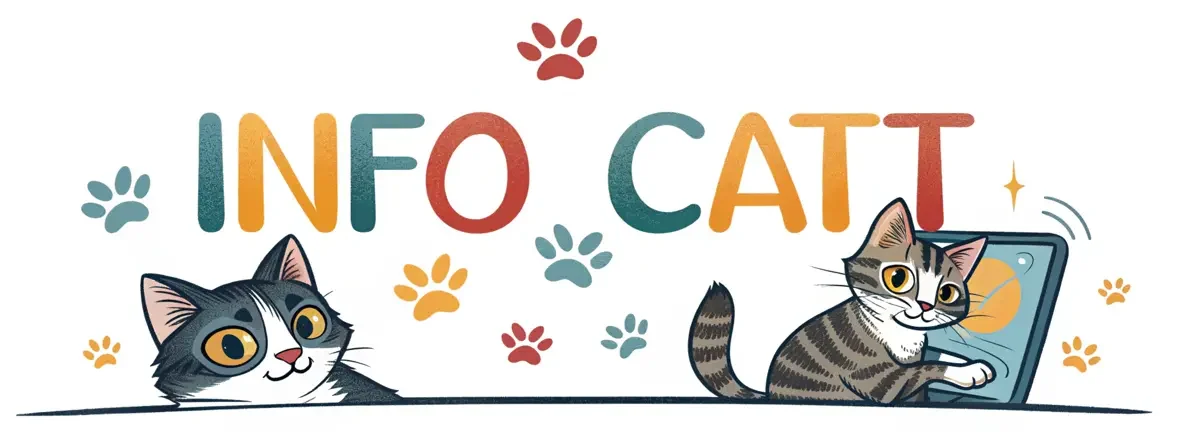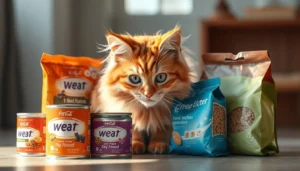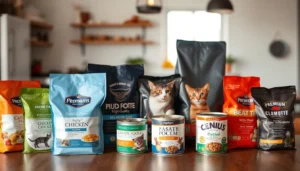Every cat owner knows that moment of pure love when your feline companion looks up at you with those big, trusting eyes. But are you giving them the best diet for your cat that truly supports their health and happiness?
Nutrition is the cornerstone of your cat’s well-being. A balanced cat diet isn’t just about filling their bowl—it’s about providing the right nutrients that support their unique biological needs. Cats are obligate carnivores, which means their bodies are designed to thrive on a protein-rich diet that mimics their natural hunting instincts.
Understanding what goes into your cat’s food can be challenging. With countless brands and nutrition claims, choosing the right diet can feel overwhelming. But don’t worry—this guide will walk you through everything you need to know to make informed decisions about your cat’s nutrition.
Understanding Your Cat’s Nutritional Requirements
Cats are special animals with their own diet needs. They need a diet rich in protein and essential nutrients to stay healthy.
Knowing what your cat needs in their food is key for their health. Cats need high-quality protein to thrive.
Essential Proteins for Feline Health
Protein is vital for a cat’s diet. They need animal-based proteins for all amino acids. Some good sources are:
- Chicken
- Fish
- Turkey
- Beef
“A diet lacking proper protein can lead to significant health complications for cats.” – Veterinary Nutrition Experts
Vital Minerals and Vitamins
Cats also need minerals and vitamins for health. These support their immune system, bones, and metabolism.
- Calcium for strong bones
- Vitamin A for vision
- Vitamin E for cellular health
- Phosphorus for energy metabolism
Importance of Taurine in Cat Diet
Taurine is a key amino acid cats can’t make on their own. Enough taurine is crucial for heart health, vision, and reproduction. Choose cat food rich in protein and taurine for your cat’s health.
The Best Diet For Your Cat: Finding the Perfect Balance
Creating a balanced cat diet is all about knowing what your cat needs. High-quality cat food is key to keeping your cat healthy. Cats are built to eat meat better than plants.
When picking the right food for your cat, keep these points in mind:
- Protein should be the main ingredient
- Fats are important for energy and a shiny coat
- Carbs should be kept low
- Vitamins and minerals are essential
Knowing what’s in good cat food helps you choose better. Look for:
- Proteins from animals like chicken or fish
- Enough moisture
- Nutrient-rich ingredients
- Less artificial preservatives
Your cat’s age, weight, and health affect their diet. Talking to a vet can help you find the best diet for your cat.
Remember: Every cat is unique, and their nutritional needs can vary significantly.
Wet vs Dry Cat Food: Making the Right Choice
Choosing the right food for your cat can be tough. The debate between wet and dry cat food puzzles many. Each type has its own benefits for your cat’s nutrition.
Understanding cat nutrition is key. Your cat’s diet affects their health and happiness.
Exploring Wet Cat Food Benefits
Wet cat food has several advantages:
- It has more moisture, helping with hydration
- It’s richer in protein, like their natural diet
- It’s often more appealing to cats
- It can help with weight and kidney health
Understanding Dry Cat Food Advantages
Dry cat food also has its benefits:
- It’s easier to store and more convenient
- It helps keep teeth clean
- It’s usually cheaper
- It can be left out for longer
Creating a Balanced Feeding Approach
The best diet often mixes wet and dry food. Here are some tips for balanced nutrition:
- Use a mix of wet and dry food
- Ask your vet about the right amounts
- Watch your cat’s weight and adjust
- Change food types to keep things interesting
Remember, every cat is different. What works for one might not work for another. Listen to your cat’s preferences and health needs.
Premium Cat Food Brands Worth Considering
Choosing the right cat food is key for your cat’s health. It’s not just about filling their bowl. It’s about giving them the nutrients they need to stay healthy.
When looking for top cat food brands, keep an eye out for these things:
- Real meat as the first ingredient
- No artificial preservatives or fillers
- Balanced nutritional profile
- Veterinarian-recommended formulations
Brands like Royal Canin, Hill’s Science Diet, and Purina Pro Plan are known for their quality. They focus on research and make special formulas for cats at different stages of life and health.
“Nutrition is the foundation of your cat’s health. Choose wisely.” – Veterinary Nutrition Expert
Your cat’s needs are special, so talk to your vet about the best food. Think about your cat’s age, weight, how active they are, and any health issues they have.
Don’t think that expensive food is always the best. Some mid-range brands offer great nutrition without costing a lot. Always check the ingredients and choose foods with whole, recognizable ingredients over generic ones.
Along with the right diet, consider these DIY tuna cat treats as a protein-packed snack option.
Natural and Raw Food Options for Cats
Looking into natural cat food can change how your cat eats. Many pet owners are now choosing a raw diet for their cats. Learning about homemade cat food and how to feed raw can help you choose better.
👉 Safe Raw Food Preparation
When making raw meals for your cat, you must be very careful. Here are some important steps:
- Use fresh, high-quality meats from trusted sources
- Clean all surfaces well before and after use
- Freeze meats to lower the risk of parasites
- Keep everything clean while handling food
👉 Benefits of Natural Ingredients
Natural ingredients are great for your cat’s health. Whole food sources give nutrients in the best form. Raw diets can help with:
- Shiny coat
- Better digestion
- More energy
- Healthier teeth
👉 Transitioning to Raw Diet
Changing to a raw diet needs patience and slow steps. Begin by adding a little raw food to their usual diet. Watch how your cat reacts and talk to a vet to make sure they get all the nutrients they need.
Always think about your cat’s health when changing their diet.
Every cat is different. What’s good for one might not be right for another. Watching your cat closely and getting advice from a vet is important for a smooth transition to natural cat food.
Tailoring Diet to Your Cat’s Life Stage
Your cat’s nutritional needs change a lot as it grows. Knowing the right diet for each stage is key to keeping them healthy and full of energy. Kittens, adult cats, and seniors all need different foods to thrive.
Kittens need a special diet to help them grow fast. Their food should be full of:
- High-quality protein
- Essential fatty acids
- More calories
- Minerals for strong bones
Adult cats need a balanced diet to keep their muscles strong and prevent weight gain. Portion control is very important here. Look for foods that:
- Give balanced nutrition
- Help with metabolism
- Keep the body at the right weight
Senior cats need food that’s easy to digest and has extra supplements. Their diet should focus on:
- Joint health
- Kidney function
- Lower metabolism
- Fewer calories
Talking to your vet can help you find the best diet for your cat. They can tailor it to your cat’s age and health needs.
Common Dietary Mistakes to Avoid
Dealing with cat nutrition can be tough. Many pet owners make mistakes that harm their cat’s health and weight. It’s key to know these common errors to keep your cat healthy and balanced.
Good nutrition is vital for your cat’s health. While you might want to feed them as a way to show love, there are important mistakes to avoid.
👉 Preventing Overfeeding
Obesity is a big health risk for cats. To help with weight loss, follow these important tips:
- Measure portions precisely using a kitchen scale
- Follow recommended feeding guidelines based on your cat’s weight
- Limit treats to 10% of daily caloric intake
- Use interactive feeders to slow down eating
“A lean cat is a healthy cat” – Veterinary Nutrition Experts
👉 Understanding Food Allergies and Sensitivities
Cats can get food allergies that mess with their digestive system. Look out for these signs:
- Persistent skin irritations
- Chronic digestive problems
- Excessive grooming
- Recurring ear infections
👉 Dangerous Human Foods to Avoid
Some human foods are toxic to cats. A balanced diet means avoiding these dangerous foods:
- Chocolate
- Onions and garlic
- Alcohol
- Caffeine
- Raw fish and meat
Always talk to your vet to make a diet plan that fits your cat’s needs.
Conclusion
Feeding your cat is more than just putting food in a bowl. It’s about knowing what they need and making sure they get it. This means understanding their nutritional needs and creating a diet that supports their health at every stage of life. Finding the right diet takes time, research, and sometimes help from a vet.
Your cat’s diet is key to their health. It affects their energy, immune system, and overall well-being. By looking into different foods, knowing what they need at different ages, and avoiding common mistakes, you can keep your cat healthy and full of life.
Regular vet visits are important to fine-tune your cat’s diet. Watch how they’re doing, keep an eye on their weight, and be ready to change their diet as they get older. Remember, a good diet is tailored to your cat’s needs, not a one-size-fits-all solution.
With the right knowledge about nutrition and food, you can make better choices for your cat’s diet. Your dedication to proper nutrition will greatly improve your cat’s life and how long they live.
FAQ
What are the most important nutrients for my cat’s diet?
Cats need a lot of protein because they are meat-eaters. They require animal proteins and amino acids like taurine. They also need vitamins A and E, and minerals like calcium and phosphorus for health.
How much should I feed my cat?
The food amount depends on your cat’s age, weight, and activity. Adult cats usually need 200-300 calories a day. Talk to your vet to find out the right amount for your cat.
Is wet or dry food better for my cat?
Both wet and dry foods have good points. Wet food helps with hydration, while dry food is easy to use and good for teeth. Many vets suggest mixing both for a balanced diet.
Can I make homemade cat food?
Making homemade cat food is hard to do right. If you try, talk to a vet nutritionist to make sure it’s balanced. The wrong diet can harm your cat’s health.
How do I know if my cat has a food allergy?
Signs of food allergies include skin problems, stomach issues, and ear infections. Common allergens are beef, dairy, chicken, and fish. If you think your cat has an allergy, see your vet for a special diet.
What human foods are dangerous for cats?
Foods like chocolate, onions, garlic, grapes, raisins, and alcohol are bad for cats. Caffeine, raw eggs, and raw meat are also risky. Always check with your vet before giving your cat human food.
How often should I change my cat’s diet?
Changing diets should be slow to avoid stomach problems. Start by mixing the new food with the old, gradually increasing the new food over 7-10 days. Change diets based on your cat’s age or if your vet suggests it.
What should I look for in high-quality cat food?
Look for foods with animal protein first, few fillers, and “complete and balanced” labels from AAFCO. Think about your cat’s age, weight, and health when picking a food.



